外研版高中英语必修三【教学设计】Module3
- 格式:pdf
- 大小:277.58 KB
- 文档页数:5
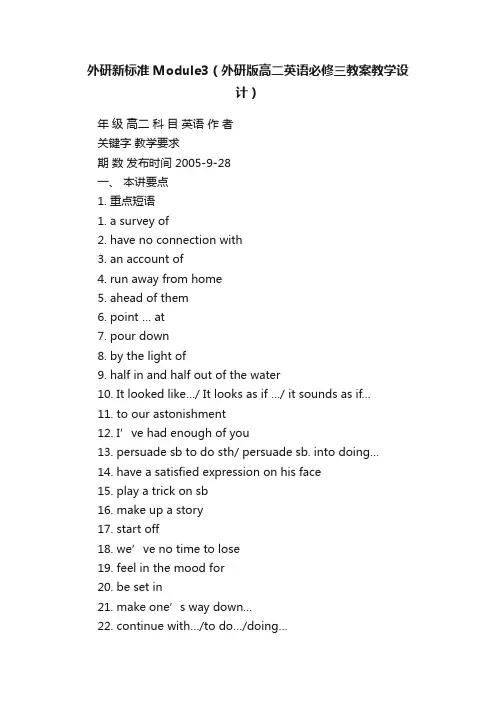
外研新标准Module3(外研版高二英语必修三教案教学设计)年级高二科目英语作者关键字教学要求期数发布时间 2005-9-28一、本讲要点1. 重点短语1. a survey of2. have no connection with3. an account of4. run away from home5. ahead of them6. point … at7. pour down8. by the light of9. half in and half out of the water10. It looked like…/ It looks as if …/ it sounds as if…11. to our astonishment12. I’ve had enough of you13. persuade sb to do sth/ persuade sb. into doing…14. have a satisfied expression on his face15. play a trick on sb16. make up a story17. start off18. we’ve no time to lose19. feel in the mood for20. be set in21. make one’s way down…22. continue with…/to do…/doing…23. hang on24. get a move on(hurry up)25. grab a bite to eat ( have a quick meal)26. to start with27. warn sb that…/ warn sb not to do…/ warn sb of/against …28. be determined to make one’s fortune29. only to find…30. force sb to do31. establish the reputation as…32. bring… back to life33. be /get/go close to sb.2. 重点句型1. it looks as if2. feel in the mood for sth3. 交际用语1. hang on a minute2. get a move on3. grab a bite to eat4. 语法Revision of verb forms二、同步课堂1. have connection with sb/sth:与某人/某物有关in connection with: 关于connect with/to sth 连接,联结Connect sb with sb /sth 使某人与某人/物有关系eg: 1) She is connected with a noble family. 她是某名门望族的亲戚。
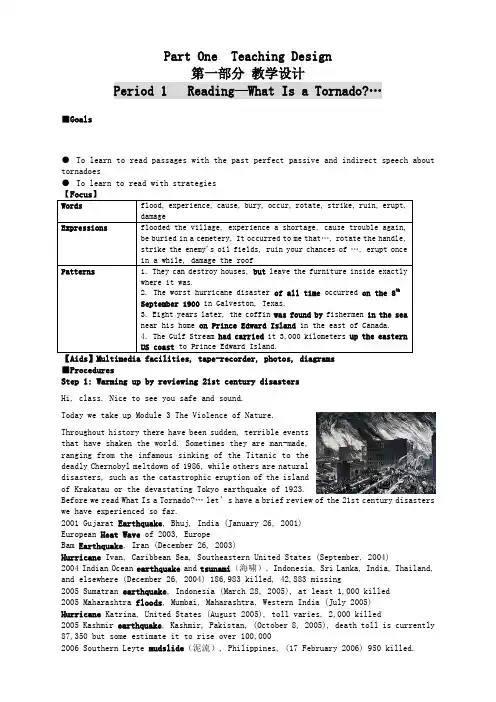
Part One Teaching Design第一部分教学设计Period 1 Reading—What Is a Tornado?…■Goals●To learn to read passages with the past perfect passive and indirect speech about tornadoes●To learn to read with strategiesWords flood, experience, cause, bury, occur, rotate, strike, ruin, erupt,damageExpressions flooded the village, experience a shortage, cause trouble again,be buried in a cemetery, It occurred to me that…, rotate the handle,strike the enemy's oil fields, ruin your chances of …, erupt oncein a while, damage the roofPatterns 1. They can destroy houses, but leave the furniture inside exactlywhere it was.2. The worst hurricane disaster of all time occurred on the 8thSeptember 1900 in Galveston, Texas.3. Eight years later, the coffin was found by fishermen in the seanear his home on Prince Edward Island in the east of Canada.4. The Gulf Stream had carried it 3,000 kilometers up the easternUS coast to Prince Edward Island.■ProceduresStep 1: Warming up by reviewing 21st century disastersHi, class. Nice to see you safe and sound.Today we take up Module 3 The Violence of Nature.Throughout history there have been sudden, terrible eventsthat have shaken the world. Sometimes they are man-made,ranging from the infamous sinking of the Titanic to thedeadly Chernobyl meltdown of 1986, while others are naturaldisasters, such as the catastrophic eruption of the islandof Krakatau or the devastating Tokyo earthquake of 1923.Before we read What Is a Tornado?…let’s have a brief review of the 21st century disasters we have experienced so far.2001 Gujarat Earthquake, Bhuj, India (January 26, 2001)European Heat Wave of 2003, EuropeBam Earthquake, Iran (December 26, 2003)Hurricane Ivan, Caribbean Sea, Southeastern United States (September, 2004)2004 Indian Ocean earthquake and tsunami(海啸), Indonesia, Sri Lanka, India, Thailand, and elsewhere (December 26, 2004) 186,983 killed, 42,883 missing2005 Sumatran earthquake, Indonesia (March 28, 2005), at least 1,000 killed2005 Maharashtra floods, Mumbai, Maharashtra, Western India (July 2005)Hurricane Katrina, United States (August 2005), toll varies, 2,000 killed2005 Kashmir earthquake, Kashmir, Pakistan, (October 8, 2005), death toll is currently 87,350 but some estimate it to rise over 100,0002006 Southern Leyte mudslide(泥流), Philippines, (17 February 2006) 950 killed.May 2006 Java earthquake, Yogyakarta, Java, Indonesia (May 27, 2006), 6,200 killed July 2006 Java earthquake, Java, Indonesia (July 17, 2006), 550 killedTyphoon Saomai (2006), Zhejiang, China, (August, 2006), 250 killedWarming up by defining tornadoA violent weather phenomenon in which a rotating column of air forms into a funnel cloud, often reaching the ground, causing severe damage.The following are facts about tornadoes:1) They may strike quickly, with little or no warning.2) They may appear nearly transparent until dust and debris are picked up or a cloud forms in the funnel.3) The average tornado moves Southwest to Northeast, but tornadoes have been known to move in any direction.4) The average forward speed of a tornado is 30 MPH, but may vary from stationary to 70 MPH.5) Tornadoes can accompany tropical storms and hurricanes as they move onto land.6) Waterspouts are tornadoes that form over water.7) Tornadoes are most frequently reported east of the Rocky Mountains during spring and summer months.8) Peak tornado season in the southern states is March through May; in the northern states, it is late spring through early summer.9) Tornadoes are most likely to occur between 3 p.m. and 9 p.m., but can occur at any time. Step 2: Before you readPlease go over the word list for this module, paying attention to the pronunciation of the word, the relationship between its pronunciation and its spelling.Step 3: While you read3. Complete the article with one word in each blankWhat Is a Tornado? Being a rotating _1_ of air from a thunderstorm to the ground tornados almost occur in the US, in the _2_from Texas in the southeast to South Dakota in the north. What Is a Hurricane? Being strong _3_ storms, hurricanes usually occur in the southern Atlantic Ocean, the Caribbean Sea and the Gulf of Mexico. There are _4_ winds of 120 kilometers per hour or more, which _5_ huge waves, heavy rain and floods.Here is an Extraordinary Event. This is a story _6_ the 1900 Galveston hurricane.Charles Coghlan, a nineteenth-century Irish actor. He died in 1899. _7_ years later, his coffin was found by fishermen in the sea near his home. The Gulf Stream had _8_ it 3,000 kilometers1. On average, there are ____tornadoes in the US each year, causing about _____deaths and _____ injuries.A. 700, 70, 1400B. 800, 80, 1500C. 600, 60, 1300D. 800, 85, 15502. The most violent tornados have winds of more than _____ kilometers per hour.A. 400B. 500C. 600D. 7003. There are on average _____ Atlantic hurricanes each year and they usually affect the east coast of the _____ from Texas to Maine.A. five, BritainB. six, USC. seven, ChinaD. eight, Japan4. The cemetery _____ Coghlan was buried was destroyed by the h urricane and Coghlan’s coffin ______ up in the sea.1. Copy all the useful expressions into your Expression Book. If possible, make your own。
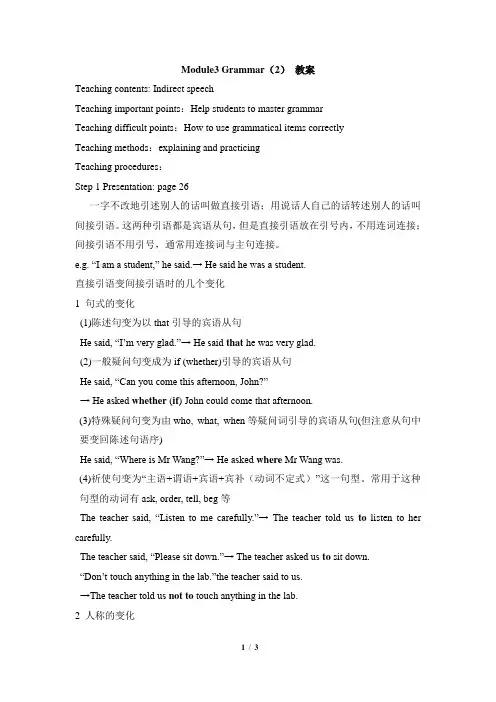
Module3 Grammar(2)教案Teaching contents: Indirect speechTeaching important points:Help students to master grammarTeaching difficult points:How to use grammatical items correctlyTeaching methods:explaining and practicingTeaching procedures:Step 1 Presentation: page 26一字不改地引述别人的话叫做直接引语;用说话人自己的话转述别人的话叫间接引语。
这两种引语都是宾语从句,但是直接引语放在引号内,不用连词连接;间接引语不用引号,通常用连接词与主句连接。
e.g. “I am a student,” he said.→ He said he was a student.直接引语变间接引语时的几个变化1 句式的变化(1)陈述句变为以that引导的宾语从句He said, “I’m very glad.”→ He said that he was very glad.(2)一般疑问句变成为if (whether)引导的宾语从句He said, “Can you come this afternoon, John?”→ He asked whether (if) John could come that afternoon.(3)特殊疑问句变为由who, what, when等疑问词引导的宾语从句(但注意从句中要变回陈述句语序)He said, “Where is Mr Wang?”→ He asked where Mr Wang was.(4)祈使句变为“主语+谓语+宾语+宾补(动词不定式)”这一句型。
常用于这种句型的动词有ask, order, tell, beg等The teacher said, “Listen to me carefully.”→ The teacher told us to listen to her carefully.The teacher said, “Please sit down.”→ The teacher asked us to sit down.“Don’t touch anything in the lab.”the teacher said to us.→The teacher told us not to touch anything in the lab.2 人称的变化I we you me us直接引语He\she they I him\her them 间接引语e.g. “Do you like English?” he asked me.→He asked me if (whether) I liked English.“I’ll help you with your maths, Wang Lin, ”Wei Fang said.→Wei Fang told Wang Lin that she would help him with his maths.“Are you going to see a film this evening?” Li Ping asked.→Li Ping asked if (whether) I was going to see a film that evening.3 时态的变化直接引语的时态间接引语的时态一般现在时一般过去时现在进行时过去进行时一般将来时过去将来时一般过去时过去完成时现在完成时过去完成时过去完成时过去完成时e.g. He said, “I’m using the knife.”→He said that he was using the knife.Zhou Lan said, “I’ll do my hmework after class.”→ Zhou Lan said that she would do her homework after class.提示:1当直接引语中的谓语动词为一般过去时时,如果与一个具体的表示过去时间的状语连用,变为间接引语时,时态可以不变。
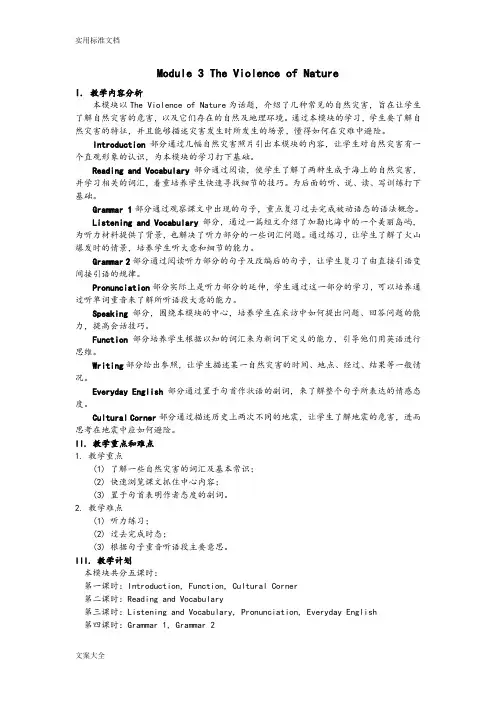
Module 3 The Violence of NatureI. 教学内容分析本模块以The Violence of Nature为话题,介绍了几种常见的自然灾害,旨在让学生了解自然灾害的危害,以及它们存在的自然及地理环境。
通过本模块的学习,学生要了解自然灾害的特征,并且能够描述灾害发生时所发生的场景,懂得如何在灾难中避险。
Introduction部分通过几幅自然灾害照片引出本模块的内容,让学生对自然灾害有一个直观形象的认识,为本模块的学习打下基础。
Reading and Vocabulary部分通过阅读,使学生了解了两种生成于海上的自然灾害,并学习相关的词汇,着重培养学生快速寻找细节的技巧。
为后面的听、说、读、写训练打下基础。
Grammar 1部分通过观察课文中出现的句子,重点复习过去完成被动语态的语法概念。
Listening and Vocabulary部分,通过一篇短文介绍了加勒比海中的一个美丽岛屿,为听力材料提供了背景,也解决了听力部分的一些词汇问题。
通过练习,让学生了解了火山爆发时的情景,培养学生听大意和细节的能力。
Grammar 2部分通过阅读听力部分的句子及改编后的句子,让学生复习了由直接引语变间接引语的规律。
Pronunciation部分实际上是听力部分的延伸,学生通过这一部分的学习,可以培养通过听单词重音来了解所听语段大意的能力。
Speaking部分,围绕本模块的中心,培养学生在采访中如何提出问题、回答问题的能力,提高会话技巧。
Function部分培养学生根据以知的词汇来为新词下定义的能力,引导他们用英语进行思维。
Writing部分给出参照,让学生描述某一自然灾害的时间、地点、经过、结果等一般情况。
Everyday English部分通过置于句首作状语的副词,来了解整个句子所表达的情感态度。
Cultural Corner部分通过描述历史上两次不同的地震,让学生了解地震的危害,进而思考在地震中应如何避险。
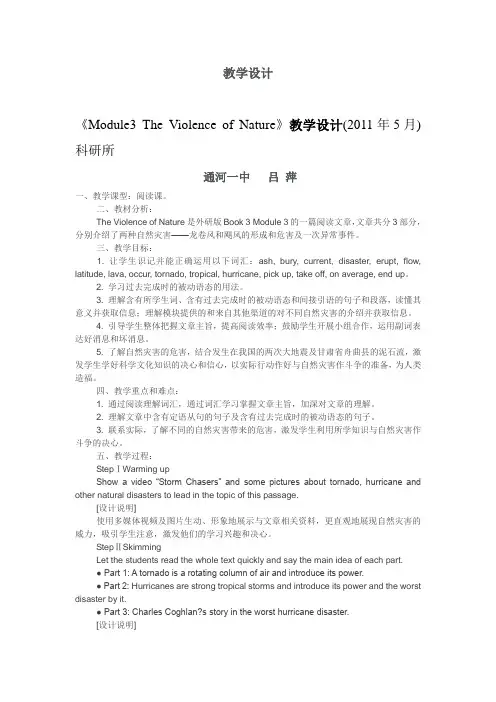
教学设计《Module3 The Violence of Nature》教学设计(2011年5月)科研所通河一中吕萍一、教学课型:阅读课。
二、教材分析:The Violence of Nature是外研版Book 3 Module 3的一篇阅读文章,文章共分3部分,分别介绍了两种自然灾害——龙卷风和飓风的形成和危害及一次异常事件。
三、教学目标:1. 让学生识记并能正确运用以下词汇:ash, bury, current, disaster, erupt, flow, latitude, lava, occur, tornado, tropical, hurricane, pick up, take off, on average, end up。
2. 学习过去完成时的被动语态的用法。
3. 理解含有所学生词、含有过去完成时的被动语态和间接引语的句子和段落,读懂其意义并获取信息;理解模块提供的和来自其他渠道的对不同自然灾害的介绍并获取信息。
4. 引导学生整体把握文章主旨,提高阅读效率;鼓励学生开展小组合作,运用副词表达好消息和坏消息。
5. 了解自然灾害的危害,结合发生在我国的两次大地震及甘肃省舟曲县的泥石流,激发学生学好科学文化知识的决心和信心,以实际行动作好与自然灾害作斗争的准备,为人类造福。
四、教学重点和难点:1. 通过阅读理解词汇,通过词汇学习掌握文章主旨,加深对文章的理解。
2. 理解文章中含有定语从句的句子及含有过去完成时的被动语态的句子。
3. 联系实际,了解不同的自然灾害带来的危害,激发学生利用所学知识与自然灾害作斗争的决心。
五、教学过程:StepⅠWarming upShow a video “Storm Chasers” and some pictures about tornado, hurricane and other natural disasters to lead in the topic of this passage.[设计说明]使用多媒体视频及图片生动、形象地展示与文章相关资料,更直观地展现自然灾害的威力,吸引学生注意,激发他们的学习兴趣和决心。
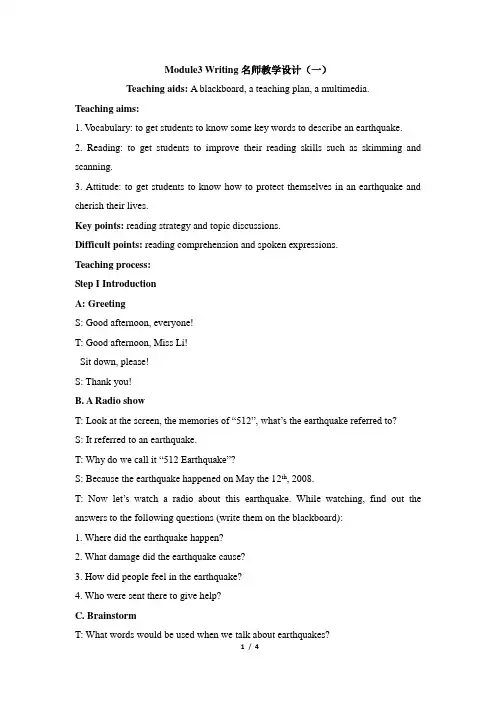
Module3 Writing名师教学设计(一)Teaching aids: A blackboard, a teaching plan, a multimedia.Teaching aims:1. V ocabulary: to get students to know some key words to describe an earthquake.2. Reading: to get students to improve their reading skills such as skimming and scanning.3. Attitude: to get students to know how to protect themselves in an earthquake and cherish their lives.Key points: reading strategy and topic discussions.Difficult points: reading comprehension and spoken expressions.Teaching process:Step I IntroductionA: GreetingS: Good afternoon, everyone!T: Good afternoon, Miss Li!Sit down, please!S: Thank you!B. A Radio showT: Look at the screen, the memories of “512”, what’s the earthquake referred to?S: It referred to an earthquake.T: Why do we call it “512 Earthquake”?S: Because the earthquake happened on May the 12th, 2008.T: Now let’s watch a radio about this earthquake. While watching, find out the answers to the following questions (write them on the blackboard):1. Where did the earthquake happen?2. What damage did the earthquake cause?3. How did people feel in the earthquake?4. Who were sent there to give help?C. BrainstormT: What words would be used when we talk about earthquakes?S: Events: Tangshan, Yushu, Tokyo, San Francisco.Damage: homes, buildings, lives, money.Feelings: sad, nervous, lonely.Rescue Work: doctors, nurses, soldiers, firefighters.Step II Reading ActivitiesA. SkimmingT: As we all know, this passage is about earthquake and this word is very important and appears many times, so it is the key word of the whole passage. Can you find out the key word of each paragraph?S: Part 1(Paragraph 1---worldwide):An introduction: how often earthquakes occurPart 2(Paragraph 2: Hua County):An example: earthquake in China (Hua County)Part 3(Paragraph 3-5: California)Another example: earthquake in the USA (California)B. ScanningT: Which paragraph does the data appear?What’s the data referred to?400 times/day 800 k㎡60% 830, 0005: 15 a. m. 1906-4-1825, 000 500250, 000 3, 000C. SummaryAbout 400 earthquakes occur worldwide per day and over 100, 000 per year. Step III Earthquake DrillsA. In the ClassroomWhat can we do to keep ourselves safe in an earthquake?1. Run out of the classroom as quickly as possible. (F)2. Jump out of the window. (F)3. Stay still. (F)4. Lean against the wall. (F)5. Hide under the desk. (T)6. Use a lift. (F)7. Keep calm. (T)B. In Other SituationsSupermarket: lean against the corner of wallIn the field: lean against the rockOutdoors: stay stillAt home: hide under the desk or the bedIn the cinema: hide under the chairC. TipsLife is only once.We must cherish our life.In an earthquake,SPEED IS LIFE.Step IV HomeworkThe earthquake is coming, but you can take only three things. What will they be? Why will you choose them?教学反思1. 视频导入,为整堂课定下基调。
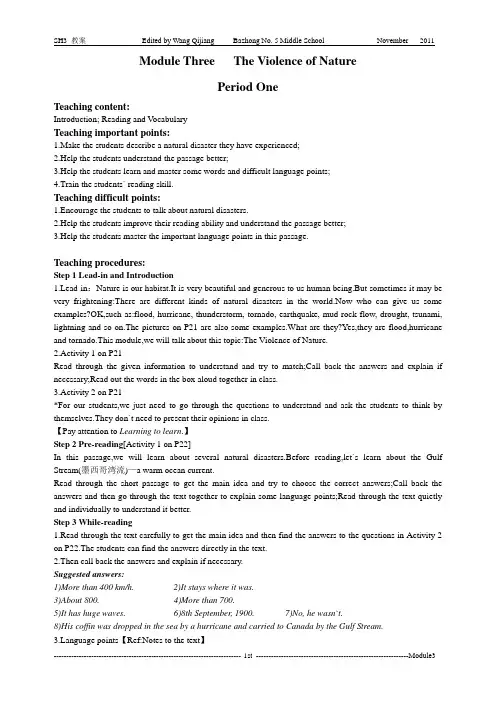
Module Three The Violence of NaturePeriod OneTeaching content:Introduction; Reading and V ocabularyTeaching important points:1.Make the students describe a natural disaster they have experienced;2.Help the students understand the passage better;3.Help the students learn and master some words and difficult language points;4.Train the students` reading skill.Teaching difficult points:1.Encourage the students to talk about natural disasters.2.Help the students improve their reading ability and understand the passage better;3.Help the students master the important language points in this passage.Teaching procedures:Step 1 Lead-in and Introduction1.Lead-in:Nature is our habitat.It is very beautiful and generous to us human being.But sometimes it may be very frightening:There are different kinds of natural disasters in the world.Now who can give us some examples?OK,such as:flood, hurricane, thunderstorm, tornado, earthquake, mud-rock flow, drought, tsunami, lightning and so on.The pictures on P21 are also some examples.What are they?Yes,they are flood,hurricane and tornado.This module,we will talk about this topic:The Violence of Nature.2.Activity 1 on P21Read through the given information to understand and try to match;Call back the answers and explain if necessary;Read out the words in the box aloud together in class.3.Activity 2 on P21*For our students,we just need to go through the questions to understand and ask the students to think by themselves.They don`t need to present their opinions in class.【Pay attention to Learning to learn.】Step 2 Pre-reading[Activity 1 on P22]In this passage,we will learn about several natural disasters.Before reading,let`s learn about the Gulf Stream(墨西哥湾流)—a warm ocean current.Read through the short passage to get the main idea and try to choose the correct answers;Call back the answers and then go through the text together to explain some language points;Read through the text quietly and individually to understand it better.Step 3 While-reading1.Read through the text carefully to get the main idea and then find the answers to the questions in Activity 2 on P22.The students can find the answers directly in the text.2.Then call back the answers and explain if necessary.Suggested answers:1)More than 400 km/h. 2)It stays where it was.3)About 800. 4)More than 700.5)It has huge waves. 6)8th September, 1900. 7)No, he wasn`t.8)His coffin was dropped in the sea by a hurricane and carried to Canada by the Gulf Stream.nguage points【Ref:Notes to the text】Go through the text together with the students to explain some language points.4.Read through the text again quietly and individually to understand it better.Time permitting,listen to the tape and follow it.Step 4 Post-reading[Activity 3 on P22]Read through the given information to understand it and try to match;Call back the answers and explain if necessary;Read out the words in the box aloud together.Step 5 Summary and Homework1.Summary: Summarize what they have learned in this period.2.Homework: Reading on P81-82 in workbook.Appendix: Notes to the text1.occur vi.▲(1)发生[=happen,take place(强调按计划)]e.g:The accident occurred at five o`clock.(=happen)▲(2)想起,想到(与to 连用)sth. occurs to sb. OR It occurs to sb. that clause(主语从句) 某人突然想起…e.g: An excellent idea occurred to me when I woke up this morning.It occurred to me that I would travel Europe.2.They can destroy houses,but leave the furniture inside exactly where it was.▲leave + O. + OC.“使…处于某状态”,宾补可以是介词短语、形容词、分词等。
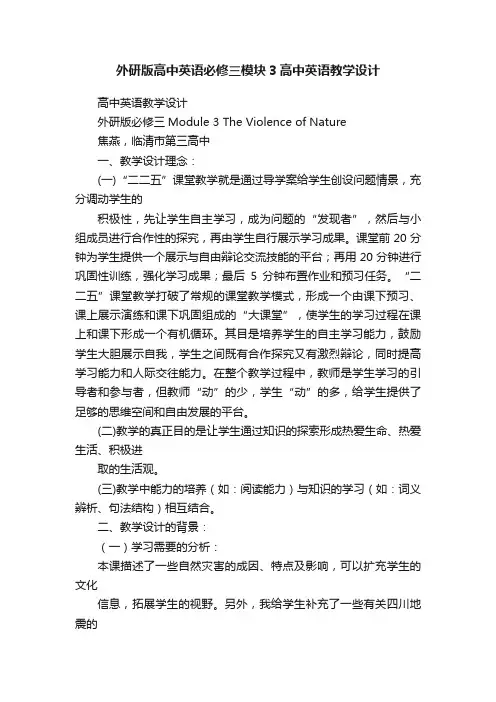
外研版高中英语必修三模块3高中英语教学设计高中英语教学设计外研版必修三Module 3 The Violence of Nature焦燕,临清市第三高中一、教学设计理念:(一)“二二五”课堂教学就是通过导学案给学生创设问题情景,充分调动学生的积极性,先让学生自主学习,成为问题的“发现者”,然后与小组成员进行合作性的探究,再由学生自行展示学习成果。
课堂前20分钟为学生提供一个展示与自由辩论交流技能的平台;再用20分钟进行巩固性训练,强化学习成果;最后5分钟布置作业和预习任务。
“二二五”课堂教学打破了常规的课堂教学模式,形成一个由课下预习、课上展示演练和课下巩固组成的“大课堂”,使学生的学习过程在课上和课下形成一个有机循环。
其目是培养学生的自主学习能力,鼓励学生大胆展示自我,学生之间既有合作探究又有激烈辩论,同时提高学习能力和人际交往能力。
在整个教学过程中,教师是学生学习的引导者和参与者,但教师“动”的少,学生“动”的多,给学生提供了足够的思维空间和自由发展的平台。
(二)教学的真正目的是让学生通过知识的探索形成热爱生命、热爱生活、积极进取的生活观。
(三)教学中能力的培养(如:阅读能力)与知识的学习(如:词义辨析、句法结构)相互结合。
二、教学设计的背景:(一)学习需要的分析:本课描述了一些自然灾害的成因、特点及影响,可以扩充学生的文化信息,拓展学生的视野。
另外,我给学生补充了一些有关四川地震的图片和英文报道,激发学生用英语获取知识和解决问题的兴趣。
(二)学习内容的分析:外研版英语教材中的每一个单元都是围绕一个独立的话题展开,包括听、说、读、写等综合技能的训练。
本单元为高一必修三第三模块,教学内容为描述自然灾害。
目的是让学生通过完成本模块的任务,能够对所学语言灵活运用,熟练掌握有关自然灾害这一话题词汇和表达句型。
并通过模块学习使学生了解地震、飓风、龙卷风等各种自然灾害的成因、过程及所造成的严重后果。
培养学生对自然科学知识的渴求,对美好生活的热爱,激发他们学好自然科学服务于生活的热情。
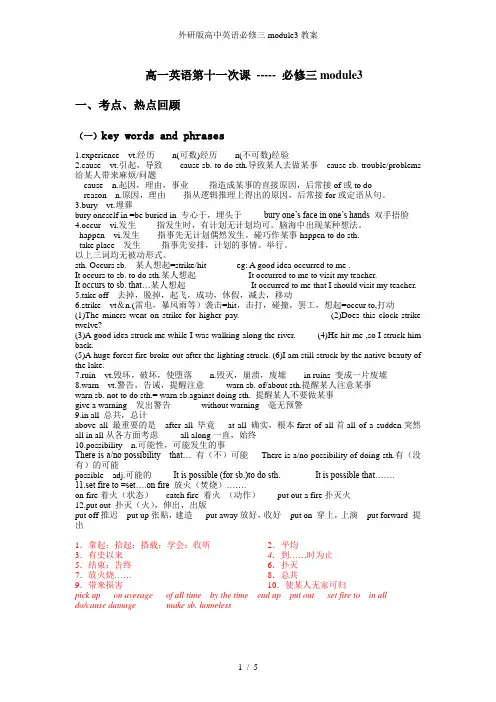
外研版高中英语必修三module3教案高一英语第十一次课----- 必修三module3一、考点、热点回顾(一)key words and phrases1.experience vt.经历n(可数)经历n(不可数)经验2.cause vt.引起,导致cause sb. to do sth.导致某人去做某事cause sb. trouble/problems 给某人带来麻烦/问题cause n.起因,理由,事业-------指造成某事的直接原因,后常接of或to doreason n.原因,理由------指从逻辑推理上得出的原因,后常接for或定语从句。
3.bury vt.埋葬bury oneself in =be buried in 专心于,埋头于bury one’s face in one’s hands 双手捂脸4.occur vi.发生-------指发生时,有计划无计划均可。
脑海中出现某种想法。
happen vi.发生------指事先无计划偶然发生。
碰巧作某事happen to do sth.take place 发生-------指事先安排,计划的事情。
举行。
以上三词均无被动形式。
sth. Occurs sb. 某人想起=strike/hit eg: A good idea occurred to me .It occurs to sb. to do sth.某人想起It occurred to me to visit my teacher.It occurs to sb. that…某人想起It occurred to me that I should visit my teacher.5.take off 去掉,脱掉,起飞,成功,休假,减去,移动6.strike vt&n.(雷电,暴风雨等)袭击=hit,击打,碰撞,罢工,想起=occur to,打动(1)The miners went on strike for higher pay. (2)Does this clock strike twelve?(3)A good idea struck me while I was walking along the river. (4)He hit me ,so I struck him back.(5)A huge forest fire broke out after the lighting struck. (6)I am still struck by the native beauty of the lake.7.ruin vt.毁坏,破坏,使堕落n.毁灭,崩溃,废墟in ruins 变成一片废墟8.warn vt.警告,告诫,提醒注意warn sb. of/about sth.提醒某人注意某事warn sb. not to do sth.= warn sb.against doing sth. 提醒某人不要做某事give a warning 发出警告without warning 毫无预警9.in all 总共,总计above all 最重要的是after all 毕竟at all 确实,根本first of all首all of a sudden突然all in all从各方面考虑all along一直,始终10.possibility n.可能性,可能发生的事There is a/no possibility that… 有(不)可能There is a/no possibility of doing sth.有(没有)的可能possible adj.可能的It is possible (for sb.)to do sth. It is possible that…….11.set fire to =set….on fire 放火(焚烧)…….on fire着火(状态)catch fire 着火(动作)put out a fire扑灭火12.put out 扑灭(火),伸出,出版put off推迟put up张贴,建造put away放好,收好put on 穿上,上演put forward 提出1.拿起;拾起;搭载;学会;收听2.平均3.有史以来4.到……时为止5.结束;告终6.扑灭7.放火烧…… 8.总共9.带来损害10.使某人无家可归pick up on average of all time by the time end up put out set fire to in alldo/cause damage make sb. homeless选词填空in all,set fire to,by the time,pick up,on average1. __________ you arrive, I will have left.2.__________, I spend two hours doing my homework every day.3.Sorry, I have to go to _______ my son from school.4.How much money does he owe you ______?5.Have the police found out who ________ the building?(二)Language PointsOn average, there are800 trnadoes in the US each year, causing about 80 deaths and 1,500 injuries.现在分词短语作结果状语The fire burned for 3 days, destroying a total of 25,000 buildings.现在分词短语作结果状语表自然而然的结果。
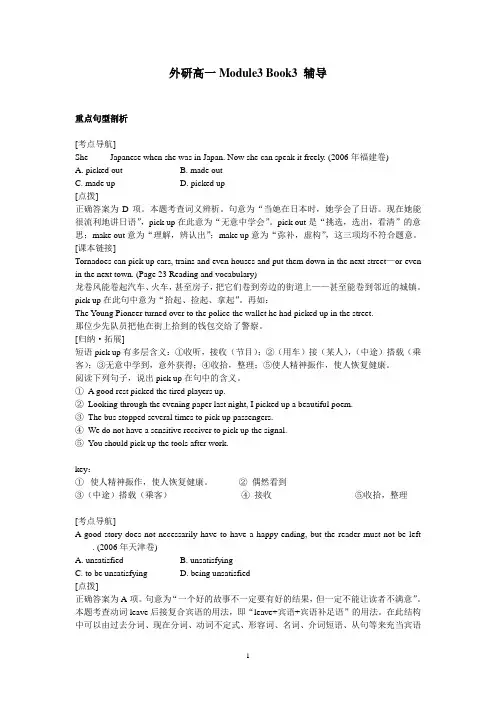
外研高一Module3 Book3 辅导重点句型剖析[考点导航]She ____ Japanese when she was in Japan. Now she can speak it freely. (2006年福建卷)A. picked outB. made outC. made upD. picked up[点拨]正确答案为D项。
本题考查词义辨析。
句意为“当她在日本时,她学会了日语。
现在她能很流利地讲日语”,pick up在此意为“无意中学会”。
pick out是“挑选,选出,看清”的意思;make out意为“理解,辨认出”;make up意为“弥补,虚构”,这三项均不符合题意。
[课本链接]Tornadoes can pick up cars, trains and even houses and put them down in the next street—or even in the next town. (Page 23 Reading and vocabulary)龙卷风能卷起汽车、火车,甚至房子,把它们卷到旁边的街道上——甚至能卷到邻近的城镇。
pick up在此句中意为“拾起、捡起、拿起”。
再如:The Young Pioneer turned over to the police the wallet he had picked up in the street.那位少先队员把他在街上拾到的钱包交给了警察。
[归纳·拓展]短语pick up有多层含义:①收听,接收(节目);②(用车)接(某人),(中途)搭载(乘客);③无意中学到,意外获得;④收拾,整理;⑤使人精神振作,使人恢复健康。
阅读下列句子,说出pick up在句中的含义。
①A good rest picked the tired players up. ___________②Looking through the evening paper last night, I picked up a beautiful poem. ___________③The bus stopped several times to pick up passengers. ___________④We do not have a sensitive receiver to pick up the signal. ___________⑤You should pick up the tools after work. ___________key:①使人精神振作,使人恢复健康。
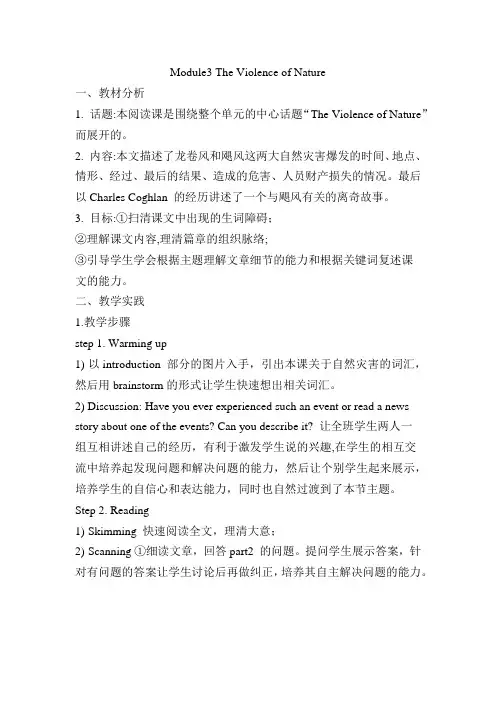
Module3 The Violence of Nature一、教材分析1. 话题:本阅读课是围绕整个单元的中心话题“The Violence of Nature”而展开的。
2. 内容:本文描述了龙卷风和飓风这两大自然灾害爆发的时间、地点、情形、经过、最后的结果、造成的危害、人员财产损失的情况。
最后以Charles Coghlan 的经历讲述了一个与飓风有关的离奇故事。
3. 目标:①扫清课文中出现的生词障碍;②理解课文内容,理清篇章的组织脉络;③引导学生学会根据主题理解文章细节的能力和根据关键词复述课文的能力。
二、教学实践1.教学步骤step 1. Warming up1)以introduction 部分的图片入手,引出本课关于自然灾害的词汇,然后用brainstorm的形式让学生快速想出相关词汇。
2) Discussion: Have you ever experienced such an event or read a news story about one of the events? Can you describe it? 让全班学生两人一组互相讲述自己的经历,有利于激发学生说的兴趣,在学生的相互交流中培养起发现问题和解决问题的能力,然后让个别学生起来展示,培养学生的自信心和表达能力,同时也自然过渡到了本节主题。
Step 2. Reading1)Skimming 快速阅读全文,理清大意;2)Scanning ①细读文章,回答part2 的问题。
提问学生展示答案,针对有问题的答案让学生讨论后再做纠正,培养其自主解决问题的能力。
②然后再从definition,speed,phenomena and worst event 几个方面比较tornado and hurricane的不同之处,旨在培养学生理解细节和提取信息的能力。
3)Exercise 进一步加强学生对文章的理解。
Step 3. Post-readingRetell the passage.组织学生重述课文内容来加强学生对全文的理解,同时也锻炼了学生的口语能力。
Period3 Listening and vocabulary;Pronunciation and Speaking课题Period3 Listening and vocabulary; Pronunciation and Speaking 课型New教学目标1. Enable the Ss to learn the part of Listening and pronunciation.2.To train the Ss speaking skills.重点train listening and speaking abilities.难点How to use the sentence patterns in communication学情分析The Ss can finish the task.教具课件 1. A recorder 2. A projector 3. A computer教法 1. question, ask and answer.2. Individual, pair or group work to make every student work in class.教学程序教学内容师生活动时间分配Step 1 Step 2 Step 3 Step 4 Step 1 Have a dictation of the words and useful expressions learnt in the text.current, latitude, furniture, bury, feather, fur, occur, tropical, equator,rotating, violent, wave, strike, cemetery, coffin.Step 2 Read the passage at Activity 1, Page 25, then fill the map and explain the process of eruption.Step 3 Listen and answer the following questions at Activity 4, Page 25.Answers: 1 In the center of Plymouth, capital of Monserra2 A reporter and Frank Savage , Governor of the island.3 No, it isn’t.4 About 6,000.5 None.6 They don’t know.Step 4 Listen to the tape and fill the blank.Report er: I’m standing in the center of Plymouth, the capital of Montserrat,where just one week ago, a ______ _________ took place.With me i s FrankSavage, the_________ of the island. Mr Savage, thank you for talking tous.Savage: You’re welcome.Reporter: What exactly _________ last week?Savage: Well, the volcano ________, and ____ and _____ poured down the mountain towards the sea. ___________, there are several villages in its path.Reporter: That’s _________. Was anybody hurt?Savage: No. _________, we had plenty of ________ and I told people who lived in the path of the ash and lava to leave the island. We ______ get half thepopulation to another island before the eruption took place.’ Reporter: Why are you still here?Savage: Well, I’m still working because there’s a lot to do.Reporter: How many people live on the island?Savage: Eleven thousand people live here and about six thousand people have left. Reporter: Which areas are the most__________?Savage: Well, the most dangerous places are between the ______ and the sea. There are a lot of villages there. And it was very dangerous. _________, hundreds of houses________ when the lava reached them.Reporter: Oh, I’m very sorry to hear that.Choosetherightanswer17’27’Step 5 Savage: _____________, no one was killed.Reporter: Are the houses still _____ _______?Savage: No. Fortunately, we _____ all the fires _____ quite quickly.Reporter: That’s very good news. Well, it’s a beautiful sunny day here in Plymouth.Does this mean that the danger ________?Savage: No! The volcano could erupt again! People must understand that it is still very dangerous and they can’t ________to their houses.Reporter: OK-So that’s the message from th e governor_______________. When will people be able to return home?Savage: We don’t know at the moment.____________, it won’t be too long. Reporter: Thank you for your time, Mr Savage.Savage: Thank you.Step 5 PronunciationListen and underline the words which the speaker stresses. These key words contain the main ideas.板书 Period3 Listening and vocabulary; Pronunciation and Speaking current, latitude, furniture, bury, feather, fur,occur, tropical, equator, rotating,violent, wave, strike, cemetery, coffin.教学后记So many usage for Ss.。
Module 3 The violence of naturePeriod 1 Introduction and Cultural cornerRead the article and answer the questions. P291.Where was the worst Chinese earthquake?2.What was the most dangerous thing about the California Earthquake of 1906?3.Is it possible that there could be another earthquake there?Careful reading (Para 1-2)True or False:1.About 500 earthquakes happen worldwide every day. ( )2.China is located in one of the most active earthquake regions in the world. ( )3.The earthquake in Shaanxi Province affected seven provinces in China. ( )4.The earthquake covered an area of 800 square kilometres. ( )5.There were 830,000 people who lost their homes. ( )Careful reading (Para 1-2) Fill in the blanks:China is______ in one of the most active earthquake regions in the world.One of the most serious _______ in Hua County in Shaanxi Province in 1556.The earthquake _______ eight provinces in Central China.It _______ an area of 800 square kilometers._______, 830,000 people _____________.Careful reading (Para 3-5)Answer the questions:1.Which earthquake was the worst in the US?2.How long did it last?3.How many buildings were destroyed by the fire which was caused by earthquake?4.Was the damage big? How many people died in the earthquake?5.What caused the earthquake?Fill in the blanks:The _____ earthquake in the US occurred in 1906 .It ____for a minute.It caused fires which destroyed __ ____ ___25,000 buildings.The earthquake and fires caused about 3,000______.The earthquake was caused by a _______ on the San Andreas Fault.One hundred years _____, movements on the San Andreas Fault ________ to cause problems for the whole of California.Language points of the cultural cornerPhrases1.be situated in2.the most active earthquake regions3.cover an area of4.lose one’s lifest for6.the worst natural disaster7.do damage8.make sb homeless9.in the whole of10.be caused bySentences1.About 400 earthquake occur worldwide every day, more than a hundred thousand in a year.(para.1)occur: vi.to happen 发生(不用于被动语态)occur---occurred---occurred---occurring他告诉我那事故是怎样发生的。
Module3 Grammar(1)精品教案Teaching contents:The past perfect passiveTeaching important points:Know the basic forms of passive voiceTeaching difficult points:How to use the past perfect passive correctlyTeaching methods:explaining and practicingTeaching procedures:Step 1 Self-study: Finish the exercises of grammar on page 32 of 世纪金榜Step 2 Presentation: page 241 what can you see from the following sentences?1 By the time the tornado ended, more than 700 people had been killed.2 Coghlan traveled back to Canada after he had been buried in Texas.3 My computer had been all right till last week.动作在过去某一时刻之前已经完成,且谓语动词与发出这一动作的主语存在被动关系。
句中常用by, before, until, when等词引导时间状语。
2 Finish the exercise at Activity 2, Page 24.Answers: 1 saw, had disappeared 2 returned, found, had been buried3 arrived, had taken4 left, had finished 5. tried, passed当从句由after, before, when或as soon as引导时,主句和从句都可以用一般过去时。
Module3 Reading and vocabulary 精品教案Teaching contents: What is a Tornado?Teaching important points: Read to get certain information about what is a tornado?What is a hurricane? And an extraordinary event Teaching difficult points: How to help students improve their reading ability Teaching methods: Listening, reading and practicingTeaching procedures:Step 1 RevisionAsk three or four students to read the word list and other students to correct their wrong pronunciations.Step 1 Presentation.Student A: reporter from one of the newspapers.Student B: interviewee.Now you are working on a special report about disasters, you need to interview some peopleQuestions like these:1 Have you ever experienced (a flood, a tornado a thunderstorm, a hurricane)?2 Do you know anyone who has experienced one of the events?3 Have you ever read a news story about one of the events? Can you describe it?4 Do you know anything about the events? For example, what causes them?Step 2 Read the Gulf Stream and check the meaning of the words.1. What is a current?A. A kind of electricityB. A movement of waterC. A kind of wind2. What kind of things flow?A. WaterB. TimeC. Money3. If two places are on the same latitude, they are on the same line______.A. east/westB. north/southStep 3 Fast-readingRead the passage, then finish the exercise at Activity 2, page 22.1. More than 400 Km/h.2. It stays where it was.3. About 800.4. More than 700.5. It has huge waves.6. 8th September, 19007. No, h e wasn’t8. His coffin was dropped in the sea by a hurricane and carried to Canada by the Gulf Stream.Step 4 Detailed-reading (True or False)1 All tornadoes have winds of more than 400 kilometres per hour.2 There are more tornadoes occurring in the US than in other parts of the world.3 Tornadoes can’t destroy furniture because they are not violent enough.4 In the US, there are usually about 80 people killed in tornadoes every year.5 The worst tornado in history killed at least 700 people6 Every year there are six Atlantic hurricanes.7 Both the worst tornado and the worst hurricane occurred in the US.8 The worst hurricane of all time killed about one-sixth of the population in the US.9 Charles Coghlan didn't become famous until he moved to New York.10 Coghlan’s coffin was destroyed by the 1900 Galveston hurricane.11 It was only because of the hurricane that Coghlan’s body could travel back to Canada.Step 5 Fill in the form.Step 6 Homework: Collect more information on Internet about one of the disasters.。